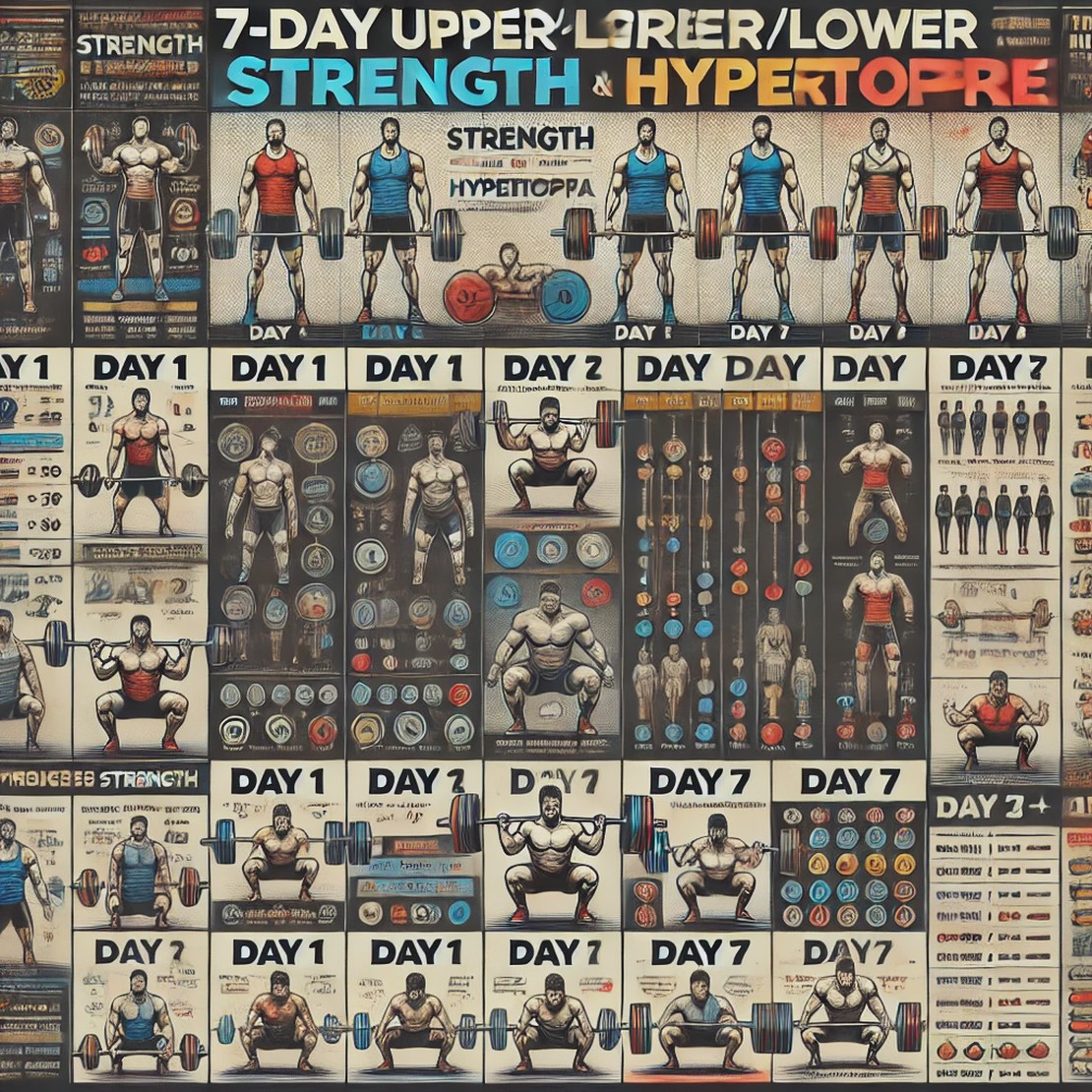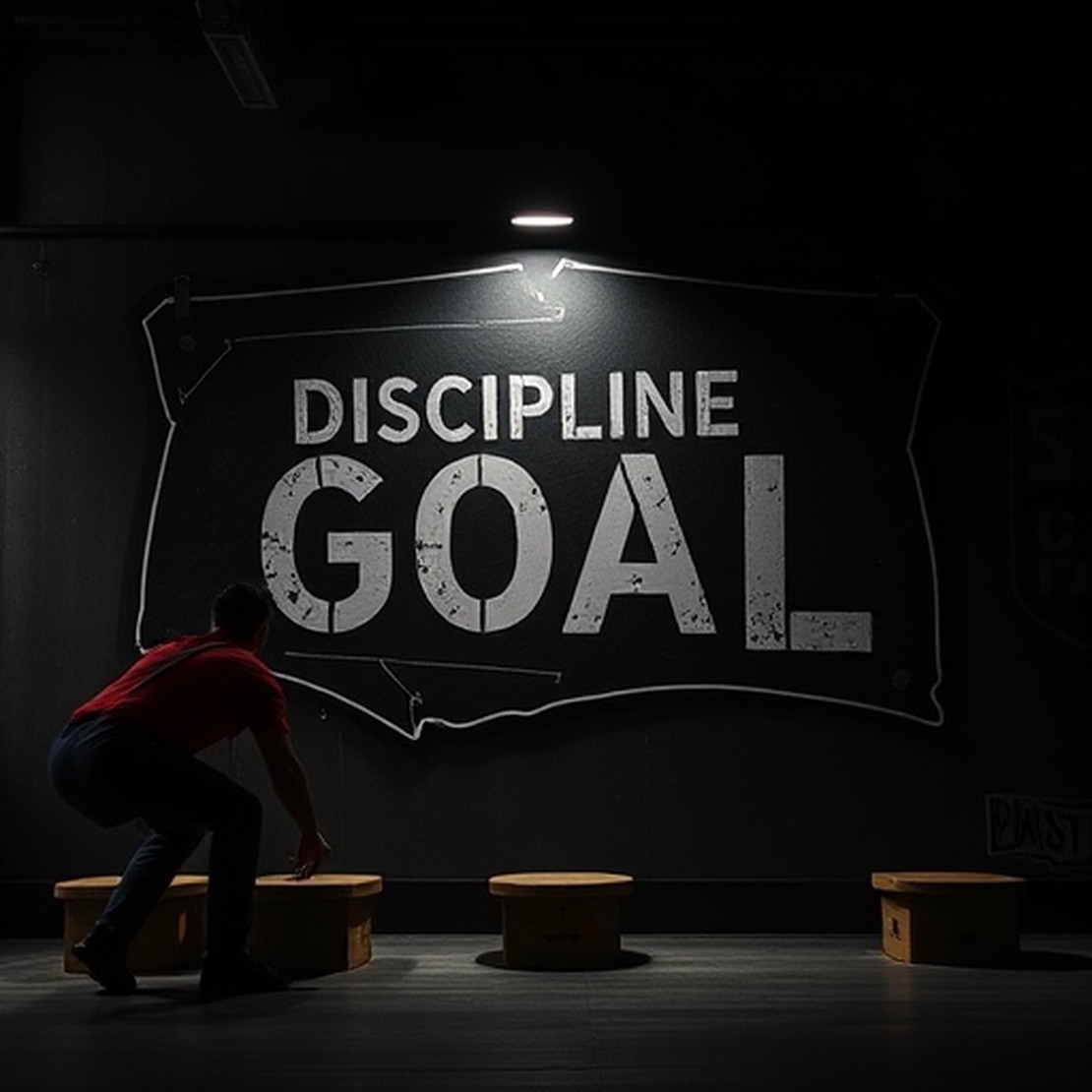
Goal: Build strength and muscle size using an upper/lower split over 7 days. This program uses only a barbell, rack, and bench, and emphasizes bench pressing 4 times per week. Each workout includes heavy low-rep strength work (3–5 reps) and moderate-to-high rep hypertrophy work (8–12+ reps) ( Rep Range For Hypertrophy ). The high-frequency bench focus is balanced with careful volume and recovery management.
Program Overview
- Equipment: Barbell, power rack, and flat bench (no machines or dumbbells needed). All exercises are barbell-based.
- Split & Frequency: Upper-body and lower-body workouts alternate across 7 days (4 upper, 3 lower). This yields bench press 4 days per week (high frequency) and squat/deadlift variations 3 days per week. High-frequency benching is a known strategy for advanced lifters (Bringing Up Your Bench Press (Frequency, Intensity, Volume …), provided volume and intensity are managed.
- Rep Ranges: Each session blends strength and hypertrophy. Heavy compound lifts are done for 3–5 reps (~80–90% of 1RM) to build maximal strength, and accessory lifts are done for 8–12+ reps (~60–75% of 1RM) to maximize muscle growth ( Rep Range For Hypertrophy ). This combination (often called powerbuilding) promotes both neural strength gains and muscular hypertrophy.
- Progressive Overload: Start with weights you can handle with good form in the given rep ranges (e.g. around 80–85% 1RM for 5 reps, 60–70% 1RM for 10 reps). Each week, attempt to increase the load by ~5 lbs (upper body) or 5–10 lbs (lower body) on your main lifts, or add a rep if using a rep range. Only increase when you hit the top of the rep range for all sets with solid form. Over time, this progressive overload drives strength and size gains.
- Volume & Recovery: Muscle groups are worked multiple times per week, but daily volume is moderate to allow recovery. For example, bench press is trained 4x/week but with varying intensity (two heavy days, two lighter high-rep days) to avoid burnout. Higher frequency training can yield greater gains if volume is distributed wisely (New training frequency study: 5x beats 2x). Listen to your body – if you are excessively sore or fatigued, reduce accessory volume slightly or insert a rest day. Adequate sleep, nutrition, and hydration are essential to handle a 7-day schedule.
Weekly Schedule
Below is the day-by-day plan (Day 1 corresponds to Monday, but adjust as needed). Each day lists exercises, sets, reps, and intensity notes. Perform a thorough warm-up before heavy lifts (e.g. lighter sets ramping up) and keep 1–2 reps in reserve on most sets to manage fatigue.
Day 1 – Upper Body (Bench Focus – Strength)
Focus: Heavy bench press and row for strength, plus accessory work for hypertrophy (shoulders and arms).
- Barbell Bench Press: 4 sets × 3–5 reps @ ~85% 1RM (strength focus). Use a weight around 80–85% of your max that allows 3–5 challenging reps with near-perfect form. For a 325 lb 1RM bench, this might be ~260–275 lbs. Press explosively but under control. (Main strength lift)
- Bent-Over Barbell Row: 4 sets × 5 reps @ ~80–85% 1RM (strength focus for back). Pull the bar from just below the knee to your lower chest, squeezing shoulder blades. Keep your back flat. Use a challenging weight (e.g. ~225 lbs if 1RM row ~275). This heavy row builds upper back and lats strength to support your presses. (Secondary strength lift)
- Overhead Barbell Press: 3 sets × 8–10 reps @ ~65–70% 1RM (hypertrophy for shoulders). From the rack, press the bar overhead. Use a moderate weight you can strict-press for high reps (for example, ~135–155 lbs if 1RM OHP ~200 lbs). This adds volume to your delts and triceps after heavy benching.
- Barbell Skull Crushers: 2–3 sets × 10–12 reps (triceps hypertrophy). Lying on the bench, lower the bar to forehead or behind head, then extend. Use a lighter weight (~50–70 lbs) for a good burn in the triceps. This exercise will strengthen your triceps lockout for bench press.
- Barbell Curls: 2–3 sets × 10–12 reps (biceps hypertrophy). Standing curls with a barbell, focusing on strict form. Use a moderate weight (~50–60% 1RM curl) that allows you to hit the rep range. Strong biceps aid your back training and help balance pushing volume.
Intensity Tip: For the heavy bench and row, aim for an RPE (Rate of Perceived Exertion) around 8–9 (you should have ~1 rep left “in the tank” on each set). Avoid grinding to absolute failure on heavy sets so you can recover for the frequent benching (Bringing Up Your Bench Press (Frequency, Intensity, Volume …). On the 8–12 rep sets, use an RPE ~8 (last few reps are tough but doable). This ensures effective muscle stimulus without excessive fatigue.
Day 2 – Lower Body (Squat Focus – Strength)
Focus: Heavy back squat for strength, with posterior-chain hypertrophy work (hamstrings, glutes, calves).
- Back Squat: 4 sets × 3–5 reps @ ~80–85% 1RM (strength focus). Aim for a weight around 80–85% of your 325 lb max (~260–275 lbs) for 3–5 solid reps each set. Maintain tight form (core braced, thighs to parallel). This heavy squat builds maximal leg and core strength. (Main strength lift)
- Romanian Deadlift (RDL): 3 sets × 8–10 reps @ ~60–70% 1RM deadlift (hypertrophy for hamstrings & glutes). Use a moderate weight (perhaps ~225–275 lbs given a 455 lb deadlift max). From standing, push hips back and lower the bar down your legs until you feel a hamstring stretch, then drive hips forward. Keep back flat. RDLs add volume to posterior-chain muscles with less stress than full deadlifts (Bench Press 4 Days per Week Powerlifting Programs (2025) - Lift Vault) (Bench Press 4 Days per Week Powerlifting Programs (2025) - Lift Vault).
- Standing Barbell Calf Raise: 3 sets × 12–15 reps (calf hypertrophy). With the bar on your back (like a squat), stand on a block or plate for a deficit and raise your heels up and down. Use a lighter weight (maybe 135–185 lbs) that allows a full range of motion. Pause at the top and bottom for best effect. Strong calves aid overall leg strength and stability.
- (Optional) Planks or Barbell Ab Rollouts: 3 sets × 30–60 sec plank hold or 3 sets × 8–12 ab rollouts. Core work is optional but recommended 2–3 times per week for trunk strength. You can use a barbell with round plates as an ab-wheel for rollouts (kneel and roll the bar out and back). A strong core will help your squats, deads, and presses.
Note: Squatting and RDL on the same day is challenging. Keep the RDL moderate in load – its purpose is hypertrophy, not max weight. You should feel a stretch and contraction in the hamstrings. If lower back fatigue is high, consider reducing RDL weight or sets. You have a heavy deadlift later in the week, so manage your effort here to avoid excessive soreness.
Day 3 – Upper Body (Bench Volume & Overhead Press – Power)
Focus: Bench press for higher reps (hypertrophy), and heavy overhead press for shoulder strength. Add accessory for traps/shoulders. This day undulates intensity: bench is lighter, overhead is heavy.
- Barbell Bench Press: 3–4 sets × 8–10 reps @ ~70% 1RM (hypertrophy focus). Use a weight around 70% of max (approx 225–230 lbs if max 325) for controlled high reps. Focus on squeezing the chest at lockout. These volume sets build muscle size in the pecs and triceps after your heavy bench day.
- Overhead Press: 3 sets × 3–5 reps @ ~85% 1RM (strength focus). Increase the weight from Day 1’s OHP – here you’ll do low reps heavy (for example, ~160–170 lbs if capable). Drive the bar overhead with tight core and glutes. Heavy overhead pressing builds shoulder and triceps strength that carries over to bench stability. (Main strength lift)
- Barbell Upright Row: 3 sets × 10–12 reps (hypertrophy for traps and lateral delts). Use a lighter load (e.g. 60–80 lbs). Stand upright and pull the barbell up along your body to chest height, leading with elbows. This will target the side shoulders and trapezius for balanced upper-body development. Keep the motion controlled to avoid shoulder strain.
- (Optional) Barbell Curl or Triceps Extension: 2 sets × 12 reps. If you feel up for extra arm work, you can add a couple of sets of barbell curls or lying triceps extensions here. However, given the heavy overhead pressing (which also hits triceps), it’s fine to skip direct arms on this day if you’re still recovering from Day 1.
Recovery Tip: By now, you’ve bench pressed two days in a row (heavy on Day 1, volume on Day 3). The higher-rep bench today uses lighter weight, which promotes blood flow and recovery while still stimulating hypertrophy. This kind of daily undulating intensity (alternating heavy and light sessions) helps you bench frequently without overtraining (Bringing Up Your Bench Press (Frequency, Intensity, Volume …). Ensure you eat and rest well, as tomorrow is another heavy lower-body day.
Day 4 – Lower Body (Deadlift Focus – Strength)
Focus: Heavy deadlift for strength, then unilateral leg work for hypertrophy. Deadlifts are very taxing, so volume is lower today, and we include some single-leg training to build muscle with less weight.
- Conventional Deadlift: 3–4 sets × 3–5 reps @ ~80–85% 1RM (strength focus). Aim for ~80-85% of your 455 lb max (e.g. ~365–385 lbs). Set up with a tight, flat back, drive through heels and pull smoothly. Keep reps low and quality high. Heavy deadlifts build overall posterior-chain strength (glutes, hamstrings, back) and total-body power. (Main strength lift)
- Barbell Lunges: 3 sets × 8–12 reps each leg (hypertrophy for quads & glutes). Use a moderate weight (perhaps 95–135 lbs on your back). Step forward into a lunge, lower until your back knee nearly touches the ground, then push back up. Do all reps on one leg then switch, or alternate legs. Lunges build the quads, glutes, and stabilizers, complementing the bilateral strength work from squats and deads.
- Standing Barbell Calf Raise: 3 sets × 12–15 reps. (If calves are not too sore from Day 2, you can add another calf session here; otherwise, you can do core work instead.) If doing calves, perform as on Day 2. If skipping calves, do 3 sets of an ab exercise of your choice (planks, barbell rollouts, hanging leg raises, etc.) to strengthen your core.
- (Optional) Barbell Ab Rollout: 3 sets × 8–12 reps (core). Using the barbell as an ab-wheel (lightly loaded with 5–10 lb plates), roll out and back on your knees. Keep hips extended and core braced. This exercise intensely works the abs and is a good complement to heavy deadlifts (which also demand a strong core).
Note: It’s normal to feel fatigued in the lower back and legs after heavy deadlifts. Keep the rest between sets ~2–3 minutes on deads to recover strength. The lunge volume will provide a growth stimulus to your quads without needing another heavy squat mid-week (since squats are trained on Day 2 and Day 6). If your lower back is extremely fatigued from deadlifts, skip the optional ab rollouts or calf work to avoid overtaxing it – you’ll hit legs again in two days. Stretch and consider light active recovery (e.g. a short walk) later to promote blood flow.
Day 5 – Upper Body (Bench Focus – Strength & Volume)
Focus: A second heavy bench press day (different rep scheme), with accessory work for back and arms. We also include a bench-press variation to target triceps and chest in a higher rep range.
- Barbell Bench Press: 4 sets × 3–5 reps @ ~85–88% 1RM (strength focus). This is another heavy bench day, but you can vary the stimulus. If Day 1 was 5-rep sets, you might aim for slightly heavier triples here. For instance, work up to ~275–285 lbs for 3 reps. Focus on bar speed and tight form. By benching heavy twice a week, you practice the movement frequently to build strength (Bringing Up Your Bench Press (Frequency, Intensity, Volume …). (Main strength lift)
- Bent-Over Barbell Row (Underhand Grip): 3 sets × 8–10 reps (hypertrophy). Perform rows with a supinated (underhand) grip, which shifts emphasis slightly to the lats and biceps. Use a moderate load (~70% 1RM for 8–10 reps; e.g. 185–205 lbs). Keep your torso about 45° and pull towards your abdomen. This variation adds more volume to your back musculature for growth.
- Close-Grip Bench Press: 3 sets × 8–10 reps @ ~60–70% 1RM (hypertrophy for triceps/chest). After your heavy bench work, reduce the weight and move your hands ~ shoulder-width apart on the bar. Press for high reps, focusing on triceps lockout. (~185–205 lbs might be used here). Close-grip benching will heavily work your triceps and still hit the chest, boosting your pressing endurance and arm size.
- Barbell Bicep Curls: 2–3 sets × 8–12 reps (biceps hypertrophy). Finish with another round of curls to give the biceps extra attention (especially since they assist in rows). Use a weight you can handle for the rep range with good form. If you prefer, you can alternate this with another biceps move like an underhand barbell row or a barbell drag curl for variety.
Intensity Tip: Because this is your second heavy bench session of the week, judge your performance. If you matched or beat the weights from Day 1, great. If you feel weaker or excessively sore, it may be a sign to dial back slightly or ensure you’re recovering (eat more, sleep more). The close-grip bench is an accessory – don’t go to absolute failure; stop a rep shy so you don’t overload your triceps before the next workouts. By the end of today, your chest and triceps will have had a significant workload; they have two days (Day 6 lower, Day 7 upper) before the next heavy bench on Day 8 (the next week’s Day 1), so use that time to recover.
Day 6 – Lower Body (Squat Variation Focus – Strength & Hypertrophy)
Focus: Heavy front squat (squat variation) for strength, plus posterior-chain hypertrophy (glutes/hamstrings) and calves. This session is somewhat lighter overall than Day 2 to allow recovery, but still hits legs hard in a different way.
- Front Squat: 3–4 sets × 3–5 reps @ ~75–85% 1RM (strength focus). Front squats place the bar on your shoulders (cross-arm or clean grip) and emphasize the quads and upper back. You won’t use as much weight as the back squat – roughly 75–80% of your back squat max is a good target (for 325 back squat, maybe ~245 lbs for a triple, or ~225 lbs for 5s). Keep your torso upright and go as deep as flexibility allows. This heavy front squat trains your quads and core under slightly lower spinal load, which is useful after heavy deadlifts. (Main strength lift)
- Barbell Hip Thrust: 3 sets × 10–12 reps (hypertrophy for glutes/hamstrings). Set your upper back on the bench, place the barbell across your hips (use a pad or towel for comfort), and thrust your hips up, squeezing the glutes at the top. Use a moderate weight (perhaps 135–185 lbs to start) focusing on contraction rather than maximum load. Hip thrusts isolate the glutes and hamstrings without stressing the lower back as much as deadlifts ( The Ultimate PHUL Workout Program for Strength & Hypertrophy - SET FOR SET ), helping build hip strength and size.
- Standing Barbell Calf Raise: 3 sets × 12–15 reps (calves). Repeat as in earlier sessions. By training calves twice this week (Day 2 and Day 6), you give them enough frequency and volume to grow. If they are still sore from Day 4, you can do a lighter 2-set pump or skip them today.
- (Optional) Core/Abs: If you have time/energy, include 3 sets of an ab exercise (your choice). For example, weighted crunches holding a weight plate or barbell against your chest, 3×15. Strong abs will support your front squat posture.
Note: Front squats and hip thrusts serve as variations of the traditional back squat and deadlift that hit the legs without repeating the exact same stress. By this point in the week, your legs have seen a heavy back squat (Day 2) and a heavy deadlift (Day 4). Today’s front squat is heavy but uses lower absolute weight, and the hip thrust is high-rep to flush the muscles. This helps spur hypertrophy while giving your spine a bit of a break from maximal loads. If your legs feel extremely fatigued, you can cut back a set or reduce the weight slightly – focus on quality reps. Tomorrow’s session will shift back to upper body, giving your lower body a rest.
Day 7 – Upper Body (Bench Volume & Row Focus – Hypertrophy/Strength)
Focus: Bench press for hypertrophy and a heavy barbell row for strength (opposite of Day 1). Also includes overhead press accessory work. This wraps up the week with a final bench day (lighter high-rep) to drive muscle growth.
- Barbell Bench Press: 3–4 sets × 10–12 reps @ ~65–70% 1RM (hypertrophy focus). Use a relatively lighter load (around 65–70% of max, ~205–225 lbs) to get 10+ reps per set. Really focus on controlled tempo and squeezing the chest. This high-rep bench work will pump the muscles without over-taxing your nervous system, aiding recovery before the next heavy bench (Day 1 of next week).
- Bent-Over Barbell Row: 4 sets × 3–5 reps @ ~85% 1RM (strength focus). Go heavy on rows today (similar to Day 1). If Day 1 was 5-rep sets, you might try a bit heavier for 3–4 reps per set here. For example, if you rowed 225 lbs for 5s on Monday, try 235–245 lbs for triples today. Maintain strict form (avoid excessive jerking). A strong back is crucial for overall upper-body strength and posture. (Main strength lift)
- Overhead Press: 3 sets × 8–10 reps (hypertrophy). Do a lighter overhead press or variation (could be seated press if rack allows, or even a push press with slight leg drive) for higher reps. Use ~60% of your OHP max for 8–10 reps. After heavy shoulders on Day 3, this provides additional volume to stimulate growth in the delts. Keep the weight moderate and focus on form since your triceps may be a bit tired from benching.
- Barbell Upright Row or Shrug (Optional): 2–3 sets × 12 reps. If you want extra trap/shoulder work, you can do some high-rep upright rows (light) or barbell shrugs (heavy) to finish off. This is optional; don’t overdo it if you’re feeling fatigued from the week.
Recovery Note: This is the final workout of the week. The benching today is high-rep and relatively low intensity, which should actually help you recover while still stimulating the muscles. You’ve benched 4 times this week – a very high frequency – which research shows can be effective for strength and size when managed properly (New training frequency study: 5x beats 2x). Ensure you eat well and get plenty of rest heading into the next week. If you plan to repeat this 7-day cycle, consider taking either the rest of Day 7 off after this workout or even an entire day off (active recovery) before restarting at Day 1, especially if you feel accumulated fatigue. Some lifters might run this as a 6-day training + 1 rest day routine, e.g. rest Sunday and then repeat, which is okay if needed.
Progression & Adaptation
- Weekly Progression: Aim to gradually increase the weight or reps each week on your main lifts. For example, in Week 1 you might bench 260 lbs for 5×3, and by Week 4 work up to 275 lbs for the same reps. Small, consistent increases beat big jumps – progress by 5 lbs on upper body lifts and 5–10 lbs on lower body lifts when you can do all sets at the current weight. If you hit the top of a rep range (e.g. 12 reps) comfortably, you can raise the weight next session. This progressive overload is key to gaining strength and muscle. Keep a training log to track this.
- Deloads: Training 7 days a week is demanding. Plan to deload (reduce weight ~50% or take a few days off) every 6–8 weeks or whenever you feel burned out, to allow full recovery and adaptation.
- Exercise Variations: Feel free to swap in barbell variations to keep progress moving and address weak points. For example, you can rotate in a pause bench press (pause 1–2 sec on the chest) on volume days for more control, or use an incline bench press (if your bench is adjustable) in place of one of the high-rep bench sessions to target upper chest. Similarly, you could alternate front squats with high-bar back squats on Day 6, or do stiff-leg deadlifts instead of RDLs on Day 2 for a different hamstring stimulus. These variations can help prevent plateaus and overuse injuries while still using the barbell.
- Listening to Your Body: The program is high volume. Pay attention to signs of excessive fatigue (persistent joint pain, performance decrease, poor sleep). If needed, scale back the number of sets on smaller accessory lifts, or add a rest day (e.g. take Day 7 off and start the next week fresh on Monday). It’s important that you recover fully from session to session in order to gain strength. Muscle growth happens during recovery, so balance the workload with ample nutrition and rest. If you find 7 straight days too taxing, a schedule of 4–6 days with built-in rest might be more sustainable.
By following this program, you’ll be hitting each major movement frequently with both heavy and high-rep training – a proven approach for building strength and muscle concurrently. Bench pressing four times a week will improve your bench technique and neuromuscular efficiency due to the high practice frequency, and the inclusion of heavy squats and deadlifts ensures your lower body strength keeps pace. The mix of hypertrophy work will pack on size across your chest, shoulders, back, arms, and legs. Remember to progress gradually, focus on good form, and prioritize recovery. Consistency and progressive overload are key – over weeks and months, you will see your lifts go up and your muscles grow if you stick with it ( Rep Range For Hypertrophy ). Good luck with your training, and enjoy the gains from this upper/lower power-building split!
Sources: High-frequency training and mixed rep ranges have been shown to maximize strength and hypertrophy when volume is managed (New training frequency study: 5x beats 2x) ( Rep Range For Hypertrophy ). Bench pressing 3–4 times per week is utilized by many advanced programs to improve pressing strength, as noted by strength coach Andy Baker (Bringing Up Your Bench Press (Frequency, Intensity, Volume …). This program applies those principles in a practical weekly schedule.


